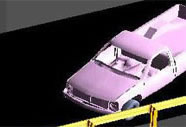 Just like trends in clothing, cars change their look and design rapidly with the times.
Just like trends in clothing, cars change their look and design rapidly with the times.
In recent years, the number of pickup trucks, passenger vans, and sport utility vehicles seen on US highways has grown substantially. Recent crash testing by the Federal Highway Administration indicates that these types of cars may be more prone to overturn when crashing into guardrails on US highways.
While guardrails cannot prevent accidents, new guardrail design may reduce the severity of accidents. A University of Cincinnati researcher is working to do just that. Ala Tabiei, assistant professor of aerospace engineering and engineering mechanics, was funded by the Federal Highway Administration (FHWA) to create a center to help design safer guardrails. The University of Cincinnati Center of Excellence is one of four similar centers in the United States that will examine various aspects of roadside safety during the next two years. Tabiei and Jin Wu, a Ph.D. student, will use the latest computer simulation techniques and high performance computing resources at the Ohio Supercomputer Center (OSC) in Columbus.
Each year, more than 14,000 people are killed and one million are injured in run-off road accidents on US roadways. Of these, more than 25 percent of the fatalities are the result of automobile rollover.**
"The University of Cincinnati Center of Excellence will assist the FHWA to develop effective, affordable, and implementable highway design treatments that will reduce the frequency and severity of vehicle rollovers," said Marty Hargrave, a research engineer for the FHWA. "The work of the Center and Dr. Tabiei will help make our highways safer for motorists."
Tabiei creates computer simulations of virtual crashes of trucks hitting a G4 1S strong post guardrail, the most popular guardrail type found on US highways. First, he creates mathematical models that represent different aspects of the guardrail, including the bolt connections and guardrail ends, and the roadway itself. Next, he uses special software, initially designed for the defense industry, known as LS-DYNA 3D to create a true simulation of what happens when the truck hits the guardrail. The simulations require a lot of computational power, so Tabiei relies on OSC's supercomputers to run his tests.
Tabiei's use of computer simulations to test guardrails is a fairly new approach for the FHWA. In the past, trucks were crashed into different guardrails until the right design was found. But today's automobiles vary more than ever in size and shape -- making it necessary to consider additional factors when designing guardrails --making tests expensive and time consuming. Tabiei's use of numerical analysis and high performance computing means fewer full-scale crash tests, possibly saving U.S. residents millions of dollars in costs related to crashes. These costs include medical bills and lost wages due to severe injuries.
Tabiei already has created a successful simulation that shows a truck rolling over upon impact with the current guardrail when the collision involves both a high speed and high angle of impact. Currently, he is changing different aspects of this simulation to find the most accurate representation, or finite element model, of the vehicle hitting the guardrail. His next step involves adding a variety of crash scenarios, such as the angle of impact, vehicle speed, and guardrail structure. These varying scenarios will help determine the final design of a safer guardrail system.
"This project is not only interesting to me as a researcher, but as a motorist," Tabiei said. "Knowing that this work may help save hundreds of lives, possibly even members of my own family, is very rewarding."
OSC is a state-supported resource serving Ohio's higher education community. The Center offers computing resources on a peer-review basis to faculty and students who are doing research in several disciplines including medicine, business, economics, engineering, chemistry, mathematics and physics. Critical partnerships, such as the Department of Defense's High Performance Computing Modernization Program and the National Computational Science Alliance, allow OSC to help position the state as a national technology leader. The Center's networking program provides Internet access to the majority of Ohio's colleges and universities and state government agencies.
**Source: Strategies for Improving Roadside Safety. National Cooperative Highway Research Program, Research Results Digest 220, November 1997.